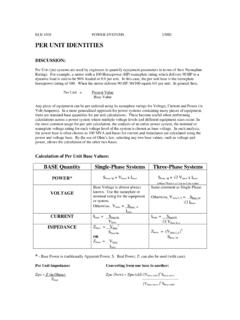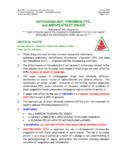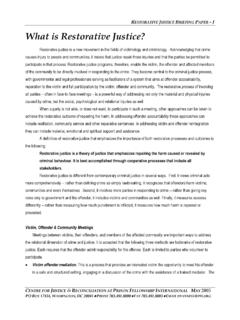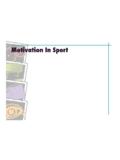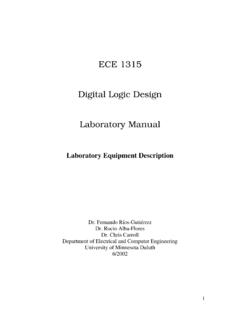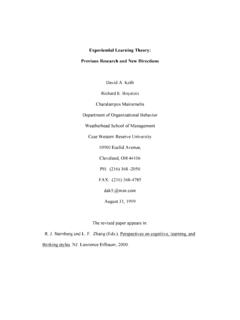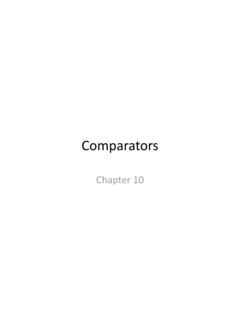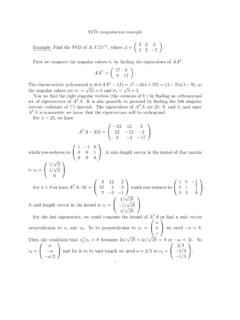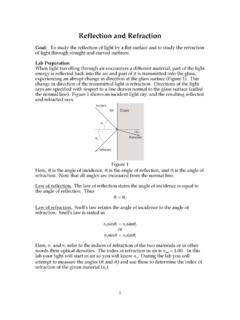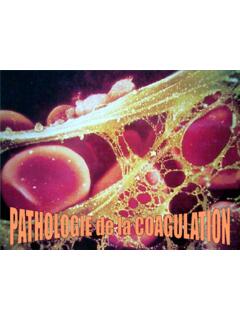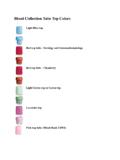Transcription of ANTICOAGULANT, THROMBOLYTIC, and ANTI-PLATELET …
1 Med 6541 Hematopoiesis and Host Defences Spring 2006 Dr. Janet Fitzakerley 307 Med Anticoagulants ~jfitzake Page 1 of 21 ANTICOAGULANT, THROMBOLYTIC, and ANTI-PLATELET DRUGS Katzung (9th ed.) Chapter 34 ** THIS VERSION HAS BEEN CHANGED COMPARED TO THE ONE MADE AVAILABLE ON WEDNESDAY APRIL 26 (sorry!) ** CRITICAL FACTS (if med school is a Minnesota forest with millions of trees, these are the red pines) 1. These drugs are used to treat strokes, myocardial infarctions, pulmonary embolisms, disseminated intravascular coagulation (DIC) and deep vein thrombosis (DVT) --- all potentially life-threatening conditions. 2. The effectiveness of thrombolytics ( clot busters ) is inversely related to the time elapsed since the thrombic crisis began these drugs are most effective within 6 hours of onset of symptoms.
2 3. The major classes of anticoagulant drugs have distinctly different mechanisms of action, routes of administration and adverse effects. The mechanisms of action include: activation of anticlotting factors (especially antithrombin III), direct inhibition of thrombin, inhibition of synthesis of blood coagulation factor precursors (zymogens), and activation of protein C. 4. A unique side effect to the use of HEPARIN is a transient thrombocytopenia (HIT) that occurs in 25% of patients. 5. The approved use of direct thrombin inhibitors (DTIs) is for the treatment of heparin-induced thrombocytopenia (HIT). 6. WARFARIN: has a NARROW THERAPEUTIC INDEX is NEARLY COMPLETELY (99%) BOUND TO PLASMA ALBUMIN is ELIMINATED BY HEPATIC METABOLISM (cytP450) WARFARIN IS THE PROTOTYPE FOR DRUG-DRUG INTERACTIONS!
3 7. DROTRECOGIN ALFA is approved for use in disseminated intravascular coagulation or DIC (fatal complication of septic shock). The use of activated protein C as a drug occurred as a result of a change in our understanding of the pathophysiology of sepsis, particularly the intricate interplay between activation of coagulation and inflammation. Med 6541 Hematopoiesis and Host Defences Spring 2006 Dr. Janet Fitzakerley 307 Med Anticoagulants ~jfitzake Page 2 of 21 DRUGS YOU NEED TO KNOW: ANTICOAGULANTS ARGATROBAN BIVALIRUDIN (Angiomax) DALTEPARIN (Fragmin) DROTRECOGIN ALFA (ACTIVATED PROTEIN C) (Xigris) ENOXAPARIN (Lovenox) FONDAPARINUX HEPARIN (Calciparine, Hepathrom, Lipo-Hepin, Liquaemin, Panheprin) HIRUDIN (Desirudin) 4-HYDROXYCOUMARIN (Coumadin) LEPIRUDIN (Refludan) WARFARIN (Athrombin-K, Panwarfin) XIMELAGATRAN (Exanta) ANTIDOTES PHYTONADIONE (Vitamin K1) PROTAMINE SULFATE AMINOCAPROIC ACID (EACA) (generic, Amicar) (in bleeding disorders handout!)
4 THROMBOLYTICS ANISTREPLASE (APSAC; Eminase) STREPTOKINASE (Streptase, Kabikinase) TISSUE PLASMINOGEN ACTIVATORS (tPAs): ALTEPLASE (Activase), RETEPLASE (Retavase), TENECTEPLASE (TNKase) UROKINASE (Abbokinase) ANTIPLATELET DRUGS ABCIXIMAB (Centocor) ACETYLSALICYLIC ACID (Aspirin) CLOPIDOGREL (Plavix) DIPYRIDAMOLE (Persantine) EPTIFIBATIDE (Integrilin) TICLOPIDINE (Ticlid) TIROFIBAN (Aggrastat) IMPORTANT MATERIAL FROM OTHER LECTURES: 1. Principles of pharmacokinetics and pharmacodynamics, esp. therapeutic index, drug metabolism, the cytochrome P450 system (Dr. Knych, Principles), and types of biological variability (Dr. Eisenberg, Principles). 2. coagulation and thrombosis (Drs. Krafts and Prohaska, Hematopoiesis).
5 OBJECTIVES: 1. Be able to diagram the coagulation and fibrinolytic pathways and the interaction of protein C with those pathways. Define how different classes of anticoagulant and fibrinolytic drugs interact with specific clotting factors and naturally occurring anticoagulants in the context of these pathways. 2. Be able to describe the biochemical mechanisms of action, therapeutic uses, contraindications and adverse effects of the specific anticoagulant and fibrinolytic agents listed above. Know the properties of agents that can reverse the actions of heparin and the oral anticoagulants. Med 6541 Hematopoiesis and Host Defences Spring 2006 Dr. Janet Fitzakerley 307 Med Anticoagulants ~jfitzake Page 3 of 21 3.
6 Describe the empirical rationale for thrombolytic therapy, its limitations and the agents that are currently approved for this purpose. Be able to identify both the common and the distinguishing characteristics of thrombolytic agents. 4. Compare and contrast: a. heparin and low molecular weight heparins b. heparin and warfarin with respect to mechanism of action, administration, time to onset of activity, method of monitoring, antidotes and use during pregnancy. 5. Understand why particular disease states and co-administration of other drugs can alter the efficacy and side effects of warfarin. Be able to describe specific pharmacokinetic and pharmacodynamic principles governing the interactions of warfarin with specific drugs listed in the main section of the handout.
7 Be able to use cytochrome P450 interaction tables to identify the interactions of other drugs with both R- and S-warfarin. 6. Know the specifics of the anti -coagulant, fibrinolytic and anti -inflammatory actions of drotrecogin alfa. THERAPEUTIC STRATEGIES Degrade fibrinogen/fibrin (fibrinolytic agents) GOAL: eliminate formed clots Inhibit clotting mechanism (anticoagulants) GOAL: prevent progression of thrombosis Interfere either with platelet adhesion and/or aggregation (antiplatelet drugs) GOAL: prevent initial clot formation These drugs are used to treat strokes, myocardial infarctions, pulmonary embolisms, disseminated intravascular coagulation (DIC) and deep vein thrombosis (DVT) --- all potentially life-threatening conditions.
8 Med 6541 Hematopoiesis and Host Defences Spring 2006 Dr. Janet Fitzakerley 307 Med Anticoagulants ~jfitzake Page 4 of 21 Med 6541 Hematopoiesis and Host Defences Spring 2006 Dr. Janet Fitzakerley 307 Med Anticoagulants ~jfitzake Page 5 of 21 THROMBOLYTIC DRUGS tPAs: ALTEPLASE, RETEPLASE, TENECTEPLASE, ANISTREPLASE, STREPTOKINASE, UROKINASE Common Features dissolve existing life-threatening thrombi activate plasminogen to plasmin hydrolysis of fibrin and several other coagulation factors plasmin formed inside a thrombus is protected from plasma antiplasmins short activation times, and short half-lives recommended for patients with: o recent acute MI (selection of patients is critical!)
9 !! Some can be harmed) o extensive pulmonary emboli o severe deep vein thrombosis o thromboembolic stroke (tPAs only) Common Contraindications/Precautions cause BLEEDING (particularly hemorrhagic stroke) can be antagonized by AMINOCAPROIC ACID (for tPAs) or APROTININ (for STREPTOKINASE) o inhibitory control system can be overwhelmed producing a systemic lytic state not for use in: 1. recent surgery (10 days) 2. GI bleeding (3 months) 3. active bleeding or hemorrhagic disorder 4. previous cerebrovascular accident or active intracranial process 5. history of hypertension (diastolic > 110 mmHg) 6. pregnancy 7. aortic dissection 8. acute pericarditis thrombolytic therapy is expensive (particularly tPAs) The effectiveness of thrombolytics is inversely related to the time elapsed since the thrombic crisis began these drugs are most effective within 6 hours of onset of symptoms Med 6541 Hematopoiesis and Host Defences Spring 2006 Dr.
10 Janet Fitzakerley 307 Med Anticoagulants ~jfitzake Page 6 of 21 1. ANISTREPLASE, STREPTOKINASE Mechanism of Action binds to and induces a conformational change in plasminogen resulting in exposure of the active site and conversion to plasmin (STREPTOKINASE itself is not intrinsically active) ANISTREPLASE is an inactive complex of STREPTOKINASE and human lys-plasminogen - more convenient (shorter infusion time) but far more expensive with an increased tendency for systemic thrombolysis Adverse Effects may evoke allergic hypersensitivity reactions, fever and anaphylaxis 2. UROKINASE Mechanism of Action kidney enzyme that directly converts plasminogen to active plasmin primarily indicated only for patients allergic to STREPTOKINASE Adverse Effects febrile episodes are common but infusion reactions and hypersensitivity (anaphylaxis) are rare 3.
